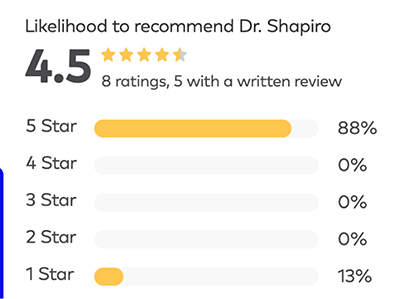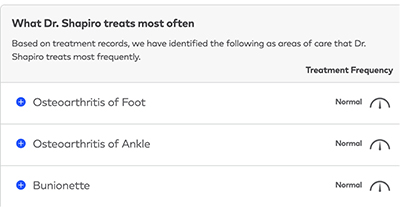
Practice Perfect 930
Online Reviews: Love ‘Em or Hate ‘Em
Online Reviews: Love ‘Em or Hate ‘Em

The other day, a patient at my practice waited too long for one of our doctors, stormed out of the office, and immediately posted a one-star review on one of the online review sites. The group practice, in which I’m a part, works hard to satisfy our patients both medically and psychologically, so this created somewhat of a buzz and had me thinking about the legitimacy of online rating systems. Should patients put stock in these doctor rating sites? Do they provide information that actually helps patients decide whom to see? Are these sites fair to doctors?
To use myself as a guinea pig for this discussion, I googled myself and found my Healthgrades rating to be first on the list (Figure 1). Now, to be clear, I’ve looked myself up exactly two times in my professional career, once when I was informed about a disgruntled patient who posted a scathing review (I couldn’t help but look) and today. I’ve never hired anyone to “manage” my reputation, and I don’t do anything to modify my rating such as enter fake reviews.

Before going deeper into my reviews, a few things stand out here. First, although the 4.5 out of 5.0 stars review is complimentary (better that than something less, I suppose), it’s the detail that are left out. It doesn’t say what characteristics lead to this rating. It doesn’t state if this is based on my clinical or surgical outcomes or if someone simply liked or disliked my bedside manner (or the staff for that matter). Were these patients grading me or their experience with my staff? Since the number is an average, some patients might have given me a very low number and others a very high number, leading to the 4.5-star average. Also, there are only 8 reviews. Is that a reasonable sample size? Not a chance.
When you scroll down a bit further, you’ll note that someone gave me one star while the other seven were 5 stars (Figure 2). I’m looking a little less bright and shiny! You may also note the statement “…5 with a written review.” Now, only 5 of my 8 reviews actually made comments, which is even less legitimate as an information source because it creates a bias toward those willing to make statements. When I looked through the specific comments, the person who rated me 1 of 5 stars didn’t make a comment. That’s too bad, I guess, because if they felt that strongly that I was a poor doctor, it would have been interesting to see why.

Interestingly, the basic information shown is mostly correct, although I no longer practice in Pomona, CA. Finally, I have to wonder about the appropriateness of posting my age. It’s really not fair to post anyone’s age, as if that’s an indicator of a good doctor. I know lots of excellent younger doctors and (thankfully) a smaller number of poor older doctors. Doesn’t this breed a discriminatory agism? Why is it ok for patients to discriminate based on age, but it is unacceptable for a doctor to do the same thing?
Scrolling down the page, I then found this ridiculous description of what disorders I supposedly most commonly treat (Figure 3). Somehow, this information is based on “treatment records”. What does that mean? Did they access my EMR and perform a data analysis? Unlikely. This information is completely erroneous. I’m in general podiatric private practice, which means I treat a large number of different lower extremity complaints. To be honest, I probably treat more toenail pathology than anything else, and my surgical procedures vary widely between forefoot and rearfoot/ankle complaints. This info, then, is totally inaccurate.

Now, the point of accessing a rating system like this for patients is, I imagine, to determine if you want to see me for your foot and ankle issues. Does this provide enough information to make that decision? Not a chance. Does it really say anything about the experience you would have coming to my office? Nope. How about my complication rates for various procedures or my success/failure rates? Zero. Does it describe my board certifications or special experience? Unfortunately, not. Do we really know if these patients actually saw me? Couldn’t I have had someone enter positive statements and a higher star rating? How do we know these patients actually saw me and not someone else? In fact, there’s another podiatrist in my area with my last name. He’s a nice guy, and patients have confused us in the past, so why not here? Maybe he’s the 5-star doc and I’m much lower. Who knows?
Now, if you look at enough of these rating systems, I’m certain you’ll find something potentially damaging to my reputation. In fact, as I mentioned above, the other time I accessed a rating system was for a highly negative review some years back. Unfortunately, I cannot respond in any way to negative comments to defend myself because it could confirm a patient saw me and may create a HIPPA violation. These negative comments live forever on the internet to plague doctors in perpetuity, leaving an opening for “reputation management” companies to create ways to “manage” doctors’ reputations online. As I understand it, this boils down to burying negative comments under a mountain of positive ones. I don’t blame any company for helping legitimate medical providers to improve their reputations because the system is stacked against providers from the start.
I don’t blame any company for helping legitimate medical providers to improve their reputations because the system is stacked against providers from the start.
The bottom line is this simplified, likely inaccurate, snapshot of a very small number of supposed patients can’t really help anyone make a legitimate decision whether or not to see a specific doctor. It’s clear that for good or ill these rating systems are here to stay, but we should all be vigilant as to the potential damage these can cause and to consider ways to minimize the damage when it occurs.
Best wishes.

Jarrod Shapiro, DPM
PRESENT Practice Perfect Editor
[email protected]





























Comments
There are 0 comments for this article